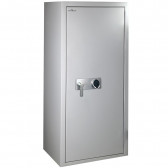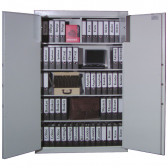A safe that is small and light may have robust security features, but will not protect the contents if it is not properly mounted. During a burglary, a thief may be able to take the safe and later open it in his own comfort. This is why some safes need to be anchored to the floor, as only then do we have a guarantee that the contents will not be stolen.
Fixing the safe to the floor – is it necessary?
It is worth knowing that the contents of a safe are protected against theft not only by special anti-theft protection of the container, but also by its proper assembly. If the safe is not heavy enough and is not anchored to the floor, thieves can attempt to carry it out, escape and open it under safe conditions. This is why VdS, the German safe certification body, recommends that any burglary safe that weighs less than 1,000 kg should be permanently mounted to the floor. The lighter the safe, the more solidly it should be fixed to the wall or floor. Certified freestanding safes therefore have holes and a set of bolts (expertly called anchors) to attach them permanently, making them very difficult or even impossible to break out and steal. It is not uncommon for safe manufacturers to specify minimum quality conditions for the substrate or wall in which the installation is to be carried out, in order to achieve adequate anchoring strength. Attachment to soft structural elements (gypsum-carton panels, furniture board) does not necessarily have to meet the manufacturer's requirements.
Why else do some safes need to be bolted to the floor?
The question of proper assembly and fixing of the safe to the ground is also important when you want to insure your property. Sometimes insurance companies require, for example, anchoring of the container for full protection. An important aspect may also be the standards and regulations that apply to companies and institutions depending on their industry. It is therefore advisable to consult the safe manufacturer and the insurance company before purchasing and installing a safe, in order to select a model that meets all requirements.
We also recommend to read: How and where to install a safe at home?
Wall and floor safes
A separate group of safes are wall or floor mounted containers. These are safes which also cannot be lifted or pulled out of the floor, but their installation requires interference in the construction of the building. It is advisable to plan for this type of safe as early as the design stage of your home or business building. A floor safe or wall safe must be built into a specially prepared recess and poured with a special concrete mix with a wall thickness of at least 100 mm. The thickness of the wall or floor in which you would like to install such a safe must therefore be considerable, or a special niche must be prepared for this purpose. The contents of such containers are protected as in a vault, and their greatest advantage is the possibility of effective concealment, e.g. behind furniture, under a carpet, etc. It is worth mentioning that some safes of this type may hide a so-called "double bottom", which will prevent theft even in the case of burglary. However, these types of specialised safes are not possible to install everywhere due to insufficiently strong walls of the building or location.





